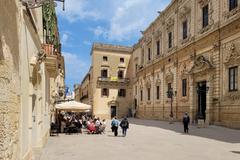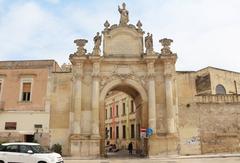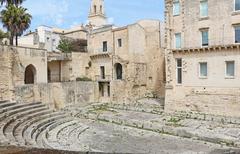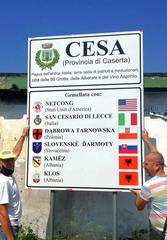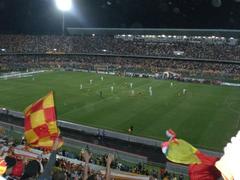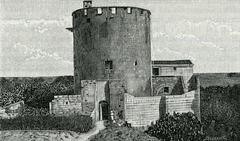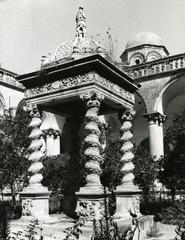Lecce Cathedral Visiting Hours, Tickets, and Historical Sites Guide
Date: 04/07/2025
Introduction
Lecce Cathedral, officially known as the Cattedrale dell’Assunzione della Vergine, is a crowning jewel of southern Italy’s Baroque heritage. Nestled in the heart of Lecce’s Piazza del Duomo, this cathedral stands as both a spiritual center and an architectural marvel—celebrated for its ornate pietra leccese carvings, dramatic facades, and rich historical layers. Originating from its Romanesque foundations in 1144, the cathedral underwent a transformative Baroque reconstruction in the 17th century under architect Giuseppe Zimbalo, shaping the exuberant urban landscape that distinguishes Lecce today. This guide offers a detailed overview of Lecce Cathedral’s history, architectural highlights, and essential visitor information, including up-to-date visiting hours, ticketing options, accessibility, and local travel tips. Whether you are an art enthusiast, history lover, or a pilgrim seeking spiritual inspiration, Lecce Cathedral promises a rewarding and memorable experience (Wikipedia; Old Town Explorer; Chiesa Lecce Official Site).
Table of Contents
- Early Foundations and Medieval Transformations
- Baroque Renaissance: 17th-Century Rebuilding
- Architectural Features and Artistic Flourishes
- The Bell Tower: Civic and Spiritual Symbol
- Piazza del Duomo: Urban Context
- Practical Visitor Information: Hours, Tickets, and Accessibility
- Tips for Visiting and Nearby Attractions
- Visuals and Interactive Media
- FAQs
- Conclusion and Visitor Summary
- Sources
Early Foundations and Medieval Transformations
Lecce Cathedral’s origins date to 1144, when its initial Romanesque structure was built as the spiritual heart of Lecce (Wikipedia). Over the centuries, the cathedral witnessed a succession of rulers—from Byzantines and Normans to the Kingdom of Naples—each leaving subtle marks on the city’s religious landscape (Maddy’s Avenue). In 1230, the cathedral underwent significant repairs, reflecting both structural needs and evolving liturgical practices.
Baroque Renaissance: 17th-Century Rebuilding
The most pivotal transformation took place in the 17th century, when Bishop Luigi Pappacoda commissioned Giuseppe Zimbalo to orchestrate a complete Baroque reconstruction. Beginning in 1659, this initiative elevated Lecce Cathedral to a new artistic and religious standard, aligning with the Counter-Reformation’s emphasis on grandeur and emotional engagement (Wikipedia; Life Part 2 and Beyond). Zimbalo’s work established the cathedral’s Latin cross plan, three naves, and a richly decorated altar consecrated in 1757, featuring the Assumption of Mary by Oronzo Tiso.
Architectural Features and Artistic Flourishes
The northern and western facades of Lecce Cathedral are Baroque masterpieces, adorned with statues of saints and intricate sculptural details in warm pietra leccese (Old Town Explorer). The northern façade, facing Piazza del Duomo, is especially striking with its statues of Saint Giusto, Saint Fortunato, and Saint Orontius. Inside, visitors encounter wooden coffered ceilings, 17th-century paintings by Giuseppe da Brindisi, and twelve side chapels decorated by renowned local artists (Wikipedia).
The crypt, a remnant of the original medieval church, was remodeled during the Baroque period. It features ninety-two columns with human figure capitals, creating a unique and contemplative space beneath the main altar.
The Bell Tower: Civic and Spiritual Symbol
Adjacent to the cathedral, the bell tower (Campanile del Duomo) was constructed between 1661 and 1682 by Zimbalo. Rising 70 meters, it stands as one of Lecce’s most visible landmarks, crowned with an octagonal lantern and a statue of Saint Orontius (Old Town Explorer). The tower offers panoramic views over Lecce and—on clear days—even the Albanian mountains.
Piazza del Duomo: Urban Context
Lecce Cathedral is the centerpiece of Piazza del Duomo, an enclosed Baroque square designed for both religious ceremony and civic gatherings (GraciaMC). The square is framed by the Bishop’s Palace, Seminary Palace, and the bell tower—together forming a harmonious urban stage that epitomizes Baroque scenography (Voyage Tips).
Practical Visitor Information: Hours, Tickets, and Accessibility
Visiting Hours
- April to September: 9:00 am – 9:00 pm
- October to March: 9:00 am – 6:00 pm
- Last admission is 15 minutes before closing. Hours may vary during special liturgical events (Chiesa Lecce Official Site).
Tickets and Admission
- LeccEcclesiae Ticket: Grants entry to Lecce Cathedral, crypt, bell tower, Basilica di Santa Croce, Chiesa di Santa Chiara, Chiesa di San Matteo, and the Antico Seminario with Museo di Arte Sacra.
- Single Ticket: €11.00 (Full), €5.00 (ages 12–17), €24.00 (Family)
- Full Ticket (LeccEcclesiae + Bell Tower Elevator): €21.00 (Full), €13.00 (ages 12–17), €48.00 (Family)
- Purchase Points: Antico Seminario, Basilica di Santa Croce, or online. Debit/credit card only.
Accessibility
- The cathedral and main sites are wheelchair accessible. The crypt and upper bell tower levels may be less accessible. Assistance is available upon request.
Dress Code
- Shoulders and knees must be covered. No sleeveless tops, mini-skirts, or hats.
Guided Tours
- Available in multiple languages. Recommended to book in advance.
Tips for Visiting and Nearby Attractions
- Best Time to Visit: Early mornings or late afternoons offer fewer crowds and beautiful lighting.
- Photography: Permitted in most areas; not allowed in the crypt.
- Duration: Allocate 1–1.5 hours for the cathedral, or 2–3 hours for all LeccEcclesiae sites.
- Nearby Attractions: Roman amphitheater, Basilica di Santa Croce, Bishop’s Palace, Seminary Palace, and the city’s Baroque old town.
- Dining & Accommodation: Try Pizza & Co or Pasticceria Natale; Palazzo Bignami B&B is a recommended nearby stay.
Visuals and Interactive Media


Frequently Asked Questions (FAQ)
Q: What are the Lecce Cathedral visiting hours?
A: From April to September, 9:00 am–9:00 pm; October to March, 9:00 am–6:00 pm. Hours may vary during religious events.
Q: How much are tickets and where can I buy them?
A: Single tickets start at €11.00; family and reduced tickets are available. Purchase at the Antico Seminario, Basilica di Santa Croce, or online.
Q: Is the cathedral accessible for wheelchair users?
A: Yes, most areas are accessible. Some sections like the crypt may pose challenges.
Q: Are guided tours available?
A: Yes, in multiple languages; booking in advance is recommended.
Q: Can I take photos inside?
A: Yes, except in the crypt.
Q: What is the dress code?
A: Shoulders and knees must be covered; no hats or sleeveless tops.
Conclusion and Visitor Summary
Lecce Cathedral is an essential landmark for anyone seeking to immerse themselves in the Baroque splendor and cultural richness of Lecce. Its layered history, from medieval origins to 17th-century Baroque rebirth, is evident in every architectural detail and artistic flourish. The cathedral’s integration within Piazza del Duomo, proximity to other historical sites, flexible visiting hours, and accessible visitor services make it a highlight of any trip to Puglia.
Whether you’re climbing the bell tower for panoramic views, exploring the chapels, or simply soaking in the atmosphere of Lecce’s historic center, Lecce Cathedral offers an inspiring journey through faith, artistry, and community. For up-to-date information, always check official sources and consider enhancing your experience with virtual tours and travel apps.
Sources
- Wikipedia
- Old Town Explorer
- Chiesa Lecce Official Site
- Maddy’s Avenue
- Life Part 2 and Beyond
- GraciaMC
- Italia.it
- Voyage Tips
- villeinsalento.com
- pugliaeveryday.com
- lionsinthepiazza.com
- thecrazytourist.com
